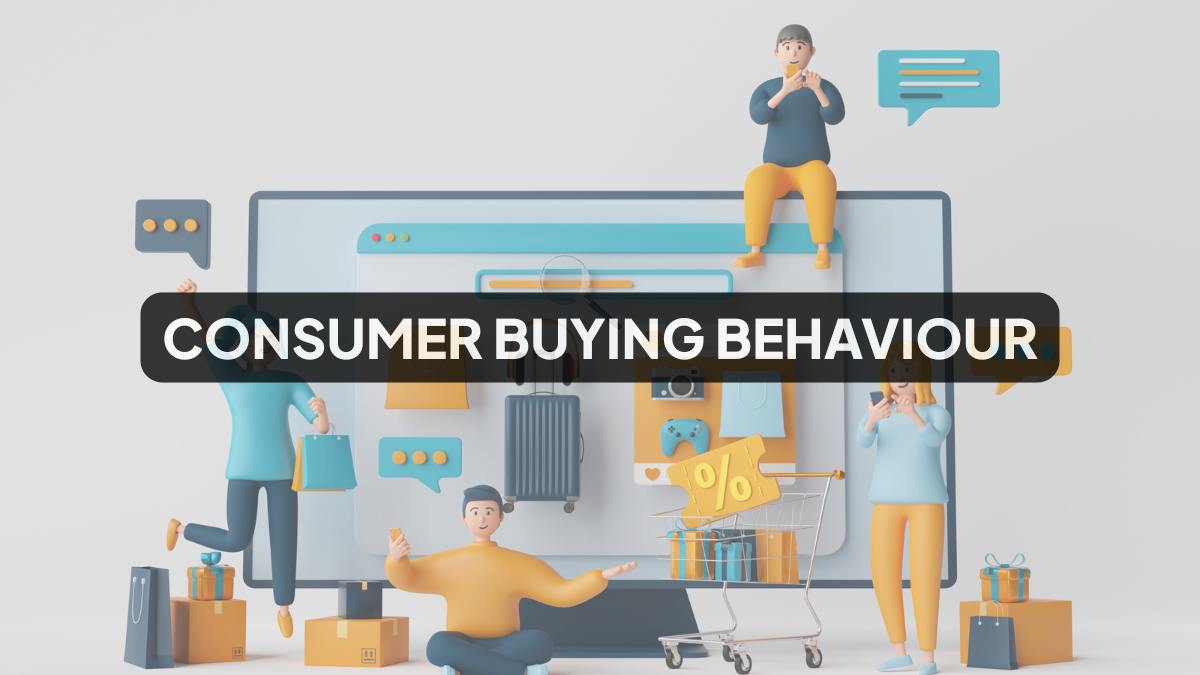Have you ever stood in a supermarket aisle, staring blankly at three different brands of toothpaste, unsure which one to toss into your cart? Or maybe you’ve spent hours researching laptops online, reading reviews, watching YouTube unboxings, only to buy the one you felt right about?
That, right there, is consumer buying behaviour in action.
It’s not just about what we buy, it’s why we buy, how we buy, and what makes us say “yes” to one product over another. For marketers, understanding this behaviour isn’t a nice-to-have. It’s the holy grail.
This blog will break down everything you need to know: the different types of consumer buying behaviour, the psychology and factors that shape it, the decision-making process, and how businesses can use this insight to build better marketing strategies.
Let’s dive in.
What is Consumer Buying Behaviour?
Table of Contents
Consumer buying behaviour refers to the decision-making process and actions of individuals when they purchase goods or services. It includes everything from how people recognize a need to what influences their final decision and how they feel after the purchase.
Why it matters:
If you know what drives a customer’s decision, you can influence it, ethically, of course. It’s about meeting people where they are, with the right message, at the right time.
A quick real-world example:
Think about Apple. People don’t just buy an iPhone because of its specs. They buy it because it represents status, simplicity, design, and maybe because “everyone else has one.” That’s Apple tapping deep into consumer psychology.
Why Understanding Consumer Behaviour is Crucial for Businesses
Most marketing fails not because of bad creatives or budgets, but because it misses the consumer’s mindset.
Understanding buying behaviour helps brands:
- Build customer-first products that solve real needs.
- Create laser-focused marketing strategies.
- Predict demand and reduce wastage in campaigns.
- Deliver better experiences that lead to retention.
For example, Netflix doesn’t just track what you watch, it understands your preferences and serves you exactly the kind of content you’re likely to binge. That’s data-driven consumer behaviour mastery.
Businesses that study consumer behaviour closely are better equipped to build loyalty and stand out in crowded markets.
Also Read: Customer-Centric Product Development
Major Types of Consumer Buying Behaviour (With Examples)
There’s no one-size-fits-all when it comes to how people buy. Behaviour changes based on involvement, product type, risk, emotion, and more.
Let’s look at the key types:
1. Complex Buying Behaviour
- High involvement, often with expensive or infrequent purchases.
- Consumers do extensive research before deciding.
Example: Buying a car, choosing a university, investing in a high-end camera.
They’re looking at reviews, comparing specs, asking friends. Emotional and rational factors both play a role.
2. Dissonance-Reducing Buying Behaviour
- High involvement, but little difference between brands.
- The goal? Reduce regret post-purchase.
Example: Buying a washing machine, most people feel unsure even after buying.
The buyer might second-guess their decision unless the brand reassures them post-purchase (through warranties or positive messaging).
3. Habitual Buying Behaviour
- Low involvement, minimal brand difference, automatic choices.
Example: Buying salt, milk, or your regular pack of chewing gum.
People don’t think twice, they pick what they always pick. The job of the marketer here? Be the default.
4. Variety-Seeking Buying Behaviour
- Low involvement but high brand switching.
Example: Trying a new shampoo not because your old one was bad, you just wanted a change.
This is where brands can win with novelty, packaging, or offers.
5. Impulsive Buying Behaviour
- Unplanned, emotionally driven purchases.
- Often triggered by visuals, moods, or limited-time offers.
Example: Grabbing a chocolate bar at checkout or buying something random during an Instagram scroll.
Marketers can trigger this with urgency cues, irresistible visuals, or emotional hooks.
6. Loyalty-Driven Buying Behaviour
- Based on trust, satisfaction, and emotional connection with the brand.
Example: Always ordering from Zomato despite similar options on Swiggy.
Loyalty programs, consistent quality, and great UX keep these customers coming back.
7. Economic Buying Behaviour
- Consumers are price-conscious and prioritize value for money.
Example: Comparing prices on Flipkart vs. Amazon before placing an order.
Discounts, bundle offers, and transparent pricing work best here.
Also Read: How to calculate LTV in performance marketing
Key Factors That Influence Consumer Buying Behaviour
So, what exactly shapes how we make buying decisions? It’s not just the product. It’s a mix of deep-rooted psychology, social context, personal circumstances, and even tech trends.
Let’s break it down:
Psychological Factors
- Motivation: What’s the buyer trying to solve?
- Perception: How do they see your brand or product?
- Learning: Past experiences or habits.
- Beliefs & Attitudes: Formed over time and influenced by content, peers, and personal values.
For example, someone who believes that eco-friendly products are superior will likely choose a sustainable brand, even if it costs more.
Personal Factors
- Age & Life Stage: Teens buy differently than retirees.
- Income: Affects choices and spending power.
- Occupation & Lifestyle: A startup founder vs. a school teacher will shop differently.
- Personality: Some people are risk-takers, others are cautious.
Social Factors
- Family & Friends: Buying a phone? You’ll probably ask your tech-savvy cousin.
- Roles & Status: A manager might dress differently to reflect their role.
- Social Circles: Peer pressure is real, even in adults.
Cultural Factors
- Culture & Subculture: What’s “normal” or desirable differs across regions.
- Social Class: Not just income, but tastes, values, and access.
For example, Diwali shopping in India often follows deep-rooted cultural traditions.
Economic Factors
- Disposable Income: Are people feeling financially secure?
- Savings & Credit Access: Can they afford a big purchase now or delay it?
- Price Sensitivity: How much does price affect their decision?
Technological & Digital Influence
- Online Reviews & Ratings: The new word-of-mouth.
- Social Media & Influencers: People buy what they see others using.
- Retargeting Ads & Algorithms: That “creepy” feeling when you see an ad for something you Googled? That’s tech nudging your behaviour.
Also Read: What is Customer Lifetime Value (LTV)
The 5 Stages of the Consumer Buying Decision Process
Every buying decision, whether it’s buying a ₹50 snack or a ₹5 lakh car, goes through a journey. Some journeys are lightning-fast (like an impulse buy), while others take weeks or even months.
But almost all follow this structure:
1. Problem/Need Recognition
It all starts here. The consumer realises they have a need, a desire, or a problem that requires a solution.
Example: You notice your old sneakers are worn out and no longer comfortable. That moment of discomfort is the spark.
This is where marketers can tap into needs through storytelling, ads, or even social media triggers that make people think: “Maybe I need this.”
2. Information Search
Once the need is clear, the consumer actively seeks information. They want options. They want answers.
This can include:
- Googling products
- Asking friends
- Watching YouTube reviews
- Reading blogs or online forums
- Visiting physical stores
For a smartphone purchase, this might mean checking out comparisons, seeing what influencers are recommending, or exploring specs on Flipkart and Amazon.
Here, SEO, paid search ads, and educational content play a massive role in grabbing attention.
3. Evaluation of Alternatives
Now, the buyer weighs the pros and cons. They’ve gathered enough data and are comparing options.
Key comparison points might be:
- Price
- Features
- Reviews
- Brand trust
- Offers or warranties
If you’re selling a product, this is where your product pages, USP clarity, and testimonials need to do the heavy lifting.
4. Purchase Decision
After consideration, the consumer finally decides: “This is the one I’m going for.”
But here’s the catch, even at this stage, a buyer can change their mind. Maybe the payment gateway crashes. Or a better deal pops up.
This is where:
- A smooth checkout experience
- Time-limited offers
- Cart reminders
- Customer support chat boxes
…can all make a huge difference.
5. Post-Purchase Behaviour
The decision has been made. But the journey doesn’t end here. This stage determines whether the buyer becomes a loyal customer, or never returns.
Post-purchase behaviour includes:
- Satisfaction or regret
- Product usage experience
- Interaction with after-sales support
- Willingness to leave a review or recommend to others
Brands like Zappos, Blinkit, or Apple win here by overdelivering. Follow-ups, thank-you messages, and loyalty rewards work wonders.
Also Read: Facebook Customer Feedback Score
Buyer Personas: The 4 Common Types of Consumers
Even though every customer is unique, certain patterns pop up. Marketers often group buyers into personas, fictional characters that represent broad user types.
Here are 4 you’ll run into often:
1. Analytical Buyers
- Data-driven, research-heavy, and logical.
- They want all the facts before buying.
- Tend to be risk-averse.
If you’re selling to them, give detailed specs, reviews, comparisons, and transparent pricing.
2. Amiable Buyers
- Value relationships, trust, and communication.
- Don’t respond well to pushy sales tactics.
- Often influenced by word-of-mouth.
Build rapport. Share testimonials. Focus on brand integrity and service quality.
3. Expressive Buyers
- Emotional, spontaneous, and trend-conscious.
- Love stories, aesthetics, and social proof.
- Heavily influenced by influencers or peer activity.
These are your Instagram-driven buyers. Think: stunning visuals, short videos, and community buzz.
4. Driver Buyers
- Action-oriented, decisive, and goal-focused.
- Don’t need a lot of fluff, they want quick, efficient decisions.
- Often time-sensitive.
For them, your messaging should be direct: “Here’s what it does. Here’s why it works. Buy now.”
Purchasing Behaviour in the Digital Age
The internet has completely reshaped how we buy. It’s not just about visiting stores anymore, it’s about experience, convenience, and instant access.
E-commerce & Mobile-First Shopping
Platforms like Amazon, Myntra, and Nykaa have made browsing, comparing, and buying seamless. Add mobile apps to the mix, and people are making purchases during coffee breaks or late-night scrolls.
AI Recommendations
From Netflix suggestions to Amazon’s “You may also like” section, AI is constantly learning your preferences and subtly nudging you toward purchases.
These recommendation engines are part of why we end up buying more than we intended.
User-Generated Content & Reviews
Most of us don’t buy without checking reviews now. In fact, real users’ opinions often matter more than brand ads.
Brands that encourage authentic feedback, repost customer photos, or showcase user stories tend to win big.
Digital Impulse Triggers
Flash sales, countdown timers, “Only 2 left in stock” banners, all designed to push immediate action.
Combine that with FOMO (fear of missing out), and even the most cautious buyers can make snap decisions.
How Marketers Can Influence Consumer Buying Behaviour
Now that we understand how people buy, let’s talk about how to ethically influence their journey.
1. Emotional Storytelling
We buy on emotion and justify with logic. Use stories that resonate, evoke nostalgia, or tap into aspirations.
Nike’s ads rarely talk about shoe specs. They talk about victory, struggle, and belief.
2. Personalisation
Tailoring content, offers, and recommendations to individual preferences makes buyers feel seen.
Email subject lines with your name. Product suggestions based on past browsing. It all adds up.
3. Remarketing
Ever seen an ad for a product you checked out yesterday? That’s remarketing at play, reminding you gently (or not-so-gently) to complete the purchase.
Facebook Pixel, Google Ads, and email automation tools like Klaviyo are essential here.
4. Trust-Building
No one buys from someone they don’t trust. Build credibility through:
- Reviews
- Certifications
- Money-back guarantees
- Clear return policies
5. Loyalty Programs
Give people a reason to come back. Points, exclusive discounts, early access, these programs deepen engagement and reduce churn.
6. Great UX (User Experience)
If your website or app is clunky, slow, or confusing, expect drop-offs. A clean design, fast loading speed, and simple navigation go a long way.

Enroll Now: Advanced Digital Marketing Course
Conclusion
Understanding Consumers = Winning the Market
If there’s one truth in marketing that never changes, it’s this:
The better you understand your consumer, the better you can serve them, and sell to them.
Consumer buying behaviour isn’t just an academic concept. It’s what drives every transaction. From teenage shoppers influenced by Instagram to elderly buyers relying on brand trust, everyone’s decisions are shaped by a complex blend of emotion, logic, habit, and influence.
Marketers and brands that invest time in understanding this, truly understanding it, aren’t just pushing products. They’re building relationships.
So ask yourself: Are you trying to sell something, or are you solving a real need for a real person?
Because the best brands? They do both.
FAQs: Consumer Buying Behaviour
1. What is an example of consumer buying behaviour?
A buyer comparing iPhones vs. Samsung Galaxy phones based on features, reviews, and price before deciding.
2. What are the five stages of the consumer buying process?
Need recognition → Information search → Evaluation → Purchase decision → Post-purchase behaviour.
3. What are the main factors that affect consumer buying behaviour?
Psychological, personal, social, cultural, economic, and digital influences.
4. What is the difference between habitual and impulsive buying behaviour?
Habitual = routine-based and repetitive.
Impulsive = spontaneous and emotionally driven.
5. How does digital marketing influence consumer buying behaviour?
Through personalization, influencer marketing, retargeting ads, and social proof.
6. Why do customers exhibit variety-seeking behaviour?
Often out of boredom or curiosity, even if they’re happy with their current product.

